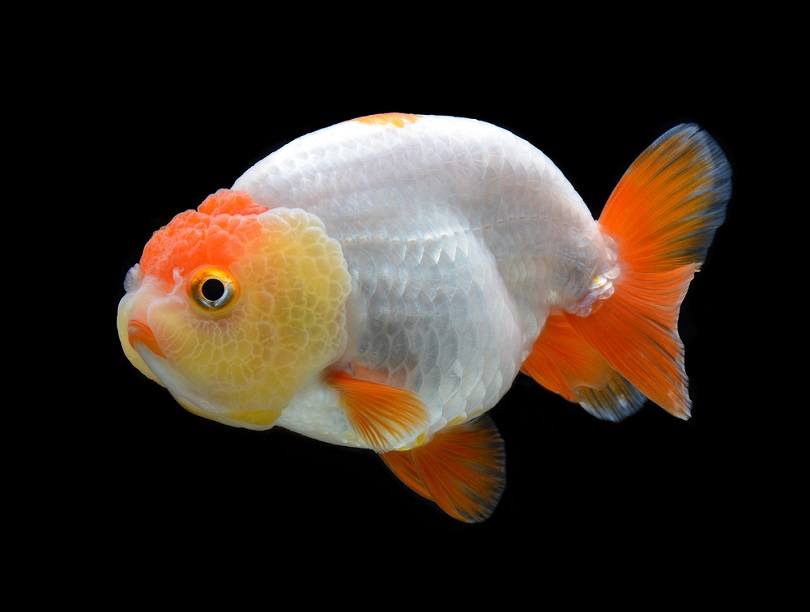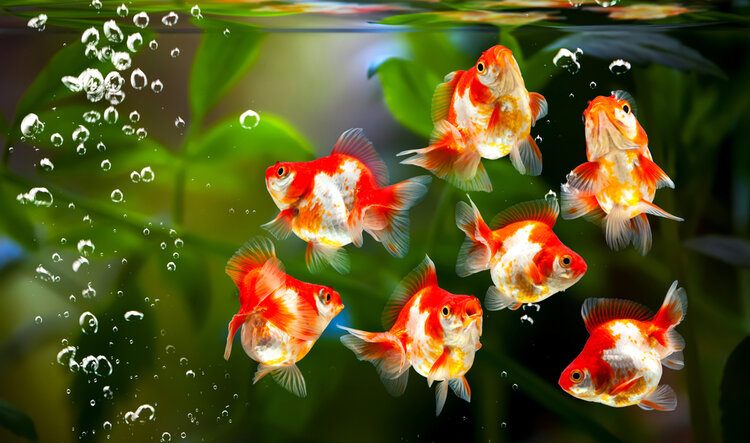Ranchu Goldfish: Pictures, Care Guide, Varieties, Lifespan & More

Updated on

The Ranchu goldfish is one of the most sought-after goldfish by collectors worldwide for its charm and rarity.
Learn more about this breed of goldfish now
Breed Features
The Ranchu goldfish is identified by its lack of a dorsal fin, its smoothly arched back, deep tail tuck, stubby fins, deep body and fluffy head growth.
The scales of the Ranchu are usually metallic, but can also come in nacreous scales.
This breed of goldfish comes in a wide variety of colors including solid red, red and white, black, blue (or silver), bi-colored, calico, nacreous or matte, solid white and others. Red or red and white are the most common.
The Ranchu is also known as the Buffalo-head goldfish for its round, large head much like a bison. The snout is almost imperceptible and it often seems as if the fish doesn’t even have one. In quality lines, the wen covers the entire head and is most extensive at the cheeks like chipmunks.
The cheeks can get very chubby with the headgrowth and, and around the eyes, it may even cover the sight, as with the Oranda goldfish. It has what is called an egg-shaped body, which is also found in several other dorsal-less breeds.

It is sometimes known as the “king of goldfish” because of its prized nature. Quality ones can even cost hundreds of dollars!
Among their owners and/or breeders, grooming has become a very popular hobby in order to achieve the most beautiful top-view of the fish.
This is done by placing the fish in shallow water with other Ranchus and feeding a very specific diet, amongst other treatments. The object of grooming is to produce a fish with a squarish head and certain body proportions.
Where to Buy Ranchu Goldfish
We love the ease and selection that eBay offers for purchasing Ranchu Goldfish. eBay has terms and conditions for the sellers, which ensure the prompt and safe delivery of the fish. Of course, as with any online purchases, you should always read the reviews from any individual seller you are considering before you purchase to protect your newest addition to your fish tank family.
Is my Fish a Ranchu? How to Identify Your Fish
This goldfish breed can be difficult to distinguish from the Lionhead because of the similarities between the breeds but can be picked out by the steeper tuck where the tail meets the body and its rounder arched back.
Additionally, the lobes of the tail splay out on the sides and the tail itself sits nearly horizontal to the body. It may also exhibit more headgrowth, but this is not always the case.
The arch of the back is not always very rounded depending on the genetics of the fish, and this may make it still more difficult to identify.
I have found Ranchus and Lionheads to be one of the most easily confused types, and only the tail seems to be the most reliable method of determining anything for certain. If you got your fish from your local chain store, it is doubtful you have a true one because of their rarity. Most likely, it is a Lionhead.

Breed History
The earliest mention of it appears in a Japanese book on the country’s oldest goldfish, but it is rather unlike the fish as we commonly know it today – the kind that develops a wen on its head (known as the Marco by Japanese goldfish keepers).
Marco Ranchus were first developed in China and continued to be modified in Japan after being brought there by the Dutch around 1603. There, it was carefully cultivated by a man named Kameyoshi Ishikawa I, who took great pains to develop the breed into what it is to this day, and its evolution continued throughout the 1800s.
The Japanese, who invented the practice of goldfish grooming, continue to judge it from above whereas the Chinese judge it from the side.
These fish are one of the most exotic of fancy goldfish and can be difficult to find locally.
How to Take Care of a Ranchu
Not many challenges exist when caring for a Ranchu goldfish, unless you decide to attempt grooming them in order to achieve the best top view. Those who practice this will vouch for the method’s ability to help the fish live longer and develop more muscles. Grooming begins once the fish begins eating pellets or reaches about 2″ long.
By feeding less, the fish produce less waste and do not accumulate as much fat. Balancing the timing of water changes is another aspect of grooming. According to the theory, fewer water changes promote more wen growth, and more frequent water changes promote faster body growth.
The water level is kept very low to promote the development of certain fins and daily water changes are done in some cases. The subject is covered in depth on this article.
Do to so much breeding, the lifespan of the Ranchu is considerably shorter than other, hardier varieties and typically lives to be around 8 years of age.

1. Feeding
Like other fancy goldfish, Ranchus are prone to swim bladder disorder due to their compact, round tummy.
A varied diet that includes plenty of veggies and live foods is a good way to prevent that from happening. Feeding foods high in protein can help promote wen development, which is desirable for this breed of goldfish. Too much protein, however, can lead to unhealthy, fatty fish.
Many fish die as a result of improper food and/or portion sizes, which can be easily prevented by proper education. That's why our best-selling book, The Truth About Goldfish, covers exactly what you can and can’t give your goldies when it comes to mealtime. It’s even got a section dedicated to keeping your pet fish alive and well-fed when you go on vacation!
You can also read more here about fancy goldfish food and diet requirements.
2. Housing
As one of the more delicate varieties, Ranchu goldfish are not well suited to pond life and are best kept indoors.
Extreme temperature changes can shock it, and it does not swim very quickly (especially as it ages), making it very susceptible to predators.
Young babies make perfect meals for snakes, as I have learned from experience.
It will do quite well in a tank size of 20 gallons for one fish indoors, though some say it can live its full life in a 10-gallon tank just as well without being stunted, as its tail does not grow long at all.

3. Temperament
Ranchus are generally good-natured and are not normally aggressive.
They may be energetic in personality, yet be hampered from doing much by their body shape and swimming ability.
Are Ranchus Good Tank Mates?
Stronger breeds should not be kept with Ranchus, as they may out-compete it at mealtimes.
Other slower-swimming varieties, such as the Telescope eye, Butterfly Tail, Lionhead or Celestial Eye, make better companions.
Read more here about choosing the best tank mates for your fish.
What do You Think?
Do you own a Ranchu goldfish?
What is your experience with keeping this much-appreciated breed of goldfish?
Let me know your thoughts in the comments below!
Featured Image Credit: bluehand, Shutterstock












